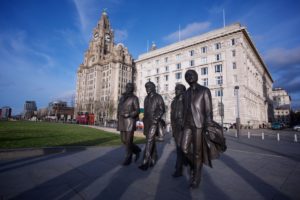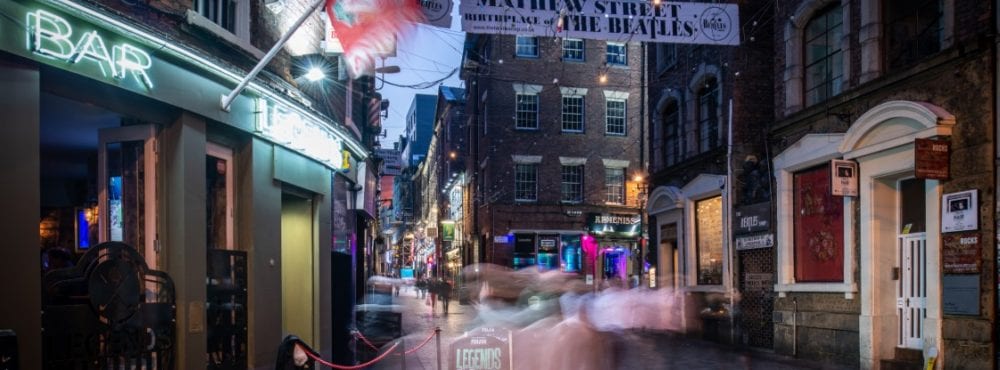On March 6, 2020, a masterplan aimed at revitalizing the epicentre of Liverpool, England’s musical heritage was approved.
Liverpool City Council’s cabinet approved a Spatial Regeneration Framework (SRF) for the Cavern Quarter, including Mathew Street—home of the world-famous music venues the Cavern Club and Eric’s—and nearby Williamson Square.
 “Liverpool’s musical heritage is an asset of global significance. This masterplan presents an opportunity to provide an experience which celebrates that unique offer and showcases the current scene. The next key step is to identify the monies needed and work with our partners to deliver these changes,” said Joe Anderson, Mayor of Liverpool, who has also created a Beatles legacy group.
“Liverpool’s musical heritage is an asset of global significance. This masterplan presents an opportunity to provide an experience which celebrates that unique offer and showcases the current scene. The next key step is to identify the monies needed and work with our partners to deliver these changes,” said Joe Anderson, Mayor of Liverpool, who has also created a Beatles legacy group.
The SRF contains a range of recommendations to help attract new investment, celebrate the current music scene and to enable the council to steer the future use of existing buildings in the area.
The document aims to address a tourism report that called for the city to curate a clearer proposition around Liverpool’s pivotal role in the story of popular and contemporary music.
“This progressive and ‘visionary’ master plan is welcome news. The Cavern Quarter, Whitechapel and Williamson Square are home to numerous historical sites that have shaped the City’s music, and cultural heritage. We need to protect and develop these sites in order to enhance these world famous attractions and to ensure Liverpool celebrates the past but also enables the creative industries to thrive in the future,” explained Peter Hooton, Chair of The Beatles Legacy Group.
A UNESCO City of Music, Liverpool’s music heritage industry—which is centered around The Beatles—is now worth more than £90 million annually, but the tourism report found visitors are increasingly looking for a higher-quality experience.
The Cavern Quarter/Williamson Square SRF was the subject of a five-week public consultation and following this approval, it will be used to guide all future planning applications within the area.
The SRF will eventually become a Supplementary Planning Document when Liverpool’s Local Plan is formally adopted in autumn 2020.
“We are so excited to hear that plans for this critical transformation of Williamson Square have now been approved – a vital step in reinvigorating this wonderful public space right on the Playhouse’s doorstep. Theatre inspires creative lives, and we are delighted to see the Playhouse standing shoulder to shoulder with both Liverpool City Council and the Liverpool BID, in creating a vibrant community space for residents and visitors alike to enjoy inside and outside of our doors,” said Fiona Gibson, Interim Chief Executive of Liverpool Everyman & Playhouse Theatres.
The city council’s cabinet also approved a SRF for the Upper Central area of the city centre, which focuses around Lime Street.
Key recommendations of the Cavern Quarter/Williamson Square SRF:
Cavern Quarter:
- Upgrade gateways into the Cavern Quarter;
- Restore and enhance the character of the area including improving street furniture and building facades;
- Animate blank walls and surfaces as part of a wider art and digital strategy;
- Enhance attractions related to the City’s music, culture and heritage to promote a multi-offer experience to visitors; and,
- Activate key nodes within the quarter, which offer opportunities for events and public art.
Whitechapel:
- Enhance the approach to Williamson Square and the Cavern Quarter via a mix of new public art, trees, lighting, balanced street principles and improved wayfinding; and,
- Develop a strategy to celebrate and interpret the street as the original “pool of Liverpool”.
Williamson Square:
- Re-design the square to include flexible performance space and enhanced public realm including seating and planting;
- Refurbishment of the St Johns extension building to improve the northern elevation of the square;
- Consider re-development of Dawson Street site if the taxi rank can be successfully relocated;
- Enhance the Playhouse’s presence on the square – spill out areas, program of events; and,
- Activate the façade of the vacant Marks & Spencer building.
The SRF also suggests creating Stakeholder Boards to assist in delivering a program of events and activities.
“Visitors from across the globe come to Liverpool to steep themselves in its musical heritage. As a city, part of our job is to give that culture and heritage the stage and setting it deserves, making it as welcoming as possible. Public spaces are vital for a healthy and vibrant city centre. This is great news for Liverpool’s visitor economy, for the businesses who work and operate on a daily basis in this destination and for music lovers who want to celebrate the city’s legend,” said Bill Addy, chief executive of Liverpool BID Company, which represents 1,500 businesses in Liverpool city centre, and chair of the Liverpool Visitor Economy Network (LVEN).
The city council is now looking at variety of funding options including Section 106 monies, city region grants and the European-funded Urban GreenUP program.
All images courtesy of Liverpool City Council.

